Lisu people
- Not to be confused with the Lahu people known in the Lahu language as Ladhulsi.
| 傈僳 | |
|---|---|
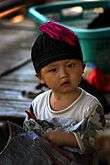 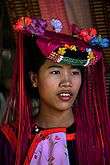 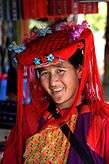 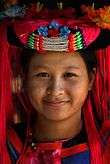 | |
| Total population | |
| (1,200,000 (est.)) | |
| Regions with significant populations | |
| China (Yunnan, Sichuan),[1] Burma (Myanmar), Thailand, North-East India ( Arunachal Pradesh) | |
| Languages | |
| Lisu, Lipo, Laemae, and Naw | |
| Religion | |
| Christianity, Animism and Buddhism |
The Lisu people (Burmese: လီဆူလူမ်ိ ုး, [lìsʰú], လီဆူလူမျိုး; Chinese: 傈 僳 族, Lìsù zú; Thai: ลีสู่; Lisu: ꓡꓲ-ꓢꓴ or ꓡꓲꓢꓴ) are a Tibeto-Burman ethnic group who inhabit mountainous regions of Burma (Myanmar), southwest China, Thailand, and the Indian state of Arunachal Pradesh.
About 730,000 Lisu live in Lijiang, Baoshan, Nujiang, Diqing and Dehong prefectures in Yunnan Province and Sichuan Province, China. The Lisu form one of the 56 ethnic groups officially recognized by the People's Republic of China. In Burma (Myanmar), the Lisu are recognized as one of 135 ethnic groups and an estimated population of 600,000 Lisu live in northern Myanmar; Kachin State (Putao, Myikyina, Danai, Waimaw, Bhamo), Shan state, (Momeik), (Namhsan, Lashio, Hopang, and Kokang) and southern Shan State (Namsang, Loilem, Mongton) and, Sagaing Division (Katha and Khamti), Mandalay Division (Mogok and Pyin Oo Lwin). Approximately 55,000 live in Thailand, where they are one of the 6 main hill tribes. They mainly inhabit remote mountainous areas.
The Lisu tribe consists of more than 58 different clans. Each family clan has its own name or surname. The biggest family clans well-known among the tribe clans are Laemae pha (Shue or The Grass, who speak Bai rather than Lisu), Bya pha (The Bee), Thorne pha, Ngwa Pha (Fish), Naw pha (Thou or Bean), Seu pha (the Woods), Khaw pha. Most of the family names came from their own work as hunters in the primitive time. However, later, they adopted many Chinese family names.[2] Their culture has traits shared with the Yi or Nuosu (Lolo) culture.[3]
History
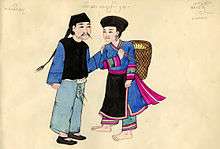
Lisu history is passed from one generation to the next in the form of songs. Today, these songs are so long that they can take an entire night to sing.[4]
Origins
The Lisu are believed to have originated in eastern Tibet even before present Tibetans arrived in the plateau. Research done by Lisu scholars indicates that they moved to northwestern Yunnan. They inhabited a region across Baoshan and the Tengchong plain for thousands of years. Lisu, Yi, Lahu, and Akha are Tibetan–Burman languages, distantly related to Burmese and Tibetan.[5][6][7][8] After the Han Chinese Ming Dynasty, around 1140-1644 CE the eastern and southern Lisu languages and culture were greatly influenced by the Han culture.[9][10] Taiping village in Yinjiang, Yunnan, China, was first established by Lu Shi Lisu people about 1,000 years ago. In the mid-18th century, Lisu peoples in Yinjiang began moving into Momeik, Burma, a population of southern Lisu moved into Mogok, and southern Shan State, and then in the late 19th century, moved into northern Thailand.[10][11][12][13] Lisu is one of the three Lolo tribes, the descendants of Yi. Yi (or Nuosu) are still much closer to the Lisu and Myanmar languages. Myat Wai Toe observes that as the saying, “the Headwaters of the Great River, Lisu originates,” where Lisu lived in “Mou-Ku-De” they were not yet called “Lisu” until 400-200 BC.[1]
[1] ျမတ္တိုးေ၀၊ လီဆူတိုင္းရင္းသားတို႔၏ဘ၀ဓေလ့ (စာေပဗိမာန္ျပည္သူ႔လက္စြဲစာစဥ္၊ ၂၀၀၈)၊ စာ ၅။
The Lisu of India
Lisu people in India are called "Yobin". In all government records, Lisu are Yobin, and sometimes used alternately. Lisu is one of the minority tribes of Arunachal Pradesh of India. They live mainly in Vijoynagar Circle in 11 villages. Gandhigram (or Shidi in Lisu) is the largest village. Lisus are found in Miao town and Injan village of Kharsang Circle Changlang District. The Lisu traditionally lived in the Yunnan Province of China and northern Myanmar. There are about 5,000 Lisu people in India.
Indian government discovers the Lisu
On 7 May 1961, the 7th Assam Rifles expedition team led by Major Sumer Singh entered the Moloshidi Valley and reached the largest village in the valley, Shidi (now called Gandhigram). They were accorded a warm reception by the villagers and further told by the villagers that they were the first ever to have visited Lisu land, Moloshidi Valley. The Assam Rifles team assured the villagers that from now on this virgin land will be under Indian rule and the people would be protected from enemy aggression. Till then there was no international boundary in the Moloshidi Valley. In 1972 the Demarcation of International Boundary with Burma was completed, largely due to Lisu project guides, the only ones with full knowledge of their region. During demarcation, cement pillars were erected at strategic elevations. In the process, the Moloshidi Valley fell on the Indian side of the boundary.
The Lisu who came to India via the Myanmar-Ledo Road
Some groups of Lisu took the then Ledo Road. Some of them worked as coal miners under British. (One certificate that originally belonged to one Aphu Lisu is a British coal miner's certificate from 1918, preserved by the Lisu). The certificate bears the mark of the then governor who ruled the region from Lakhimpur, Assam. Most of the Lisu who lived in Assam went back to Burma. However, Some are still found in Kharangkhu area of Assam, Kharsang Circle of Arunachal Pradesh. While most have lost their mother tongue, some have preserved the language and culture almost intact.[14][15]
Indian Lisu issues
In early 1980s, the government of India removed citizenship from Lisu people. They were branded as refugees. In 1994, citizenship was restored. But Scheduled Tribe status has not been reinstated. This is source of current agitation for immediate restoration by the government.
Except for the arrival of a fleet of jeeps in late 1970s, the area has been without roads and vehicles for 4 decades. The area is isolated, hence some describing the people as "prisoners of geography".
Lisu were evicted from their villages in 1964 under the command of A.S. Guarya, the late Governor General of Arunachal Pradesh. He settled Indian ex-servicemen in their villages. Those villages still retain their original names. The Lisu were chased out of their ancestral villages down to Gandhigram villages and other areas. These villages suffered from floods and lost much of their rice paddies and had to find new ground.
In 1980s, the Namdapha took over much of Lisu land. The authorities by force demarcated the boundary near Gandhigram village. This shrank the Lisu landholdings to a very small area. Since then those Lisu living in the Namdapha area have been branded as "encroachers".
Culture
The Lisu tribe consists of more than 58 different clans. Each family clan has its own name or surname. The largest families among the tribal clans are Putao Laemae pha (who speak some Bai), Bya pha (The Bee), Tung pha, Ngua Pha (Fish), Naw pha (some of them are descended from Anung or Khingphang patriclans), Seu pha (the Woods), Southern Laemae pha or Tsao jia pha (also known as a decedent of Yi tribe people), Khaw pha. Most of the family names came from their own work as hunters in primitive times. However, later, they adopted many Chinese family names.
After the Ming Dynasty, most Hua Lisu people had become a people that lived in villages high in the mountains or in mountain valleys. However, those who still lived in the Paoshan plains, standing on the side of the Qing Dynasty, fought against the Kingdom of Ming. The Lisu knife ladder climbing festival was first held as a memorial event of victory over Ming in 1644 CE. The Lisu people adopted their own traditional dance so called "che-ngoh-che" along with the Lisu guitar which has no bars on the fretboard from Han Chinese. They also used a musical instrument called fulu jewlew possibly invented by Yi tribe people. It is a kind of flute that has about six or seven small bamboo tubes tied up together to a dried-hollow-gourd.
Songs and dances differ according to the occasion. Weddings, homecomings, harvests, and other ceremonial events all have their corresponding music and dances.
Lisu villages are usually built close to water to provide easy access for washing and drinking.[9] Their homes are usually built on the ground and have dirt floors and bamboo walls, although an increasing number of the more affluent Lisu are now building houses of wood or even concrete.[4]
Lisu subsistence was based on paddy fields, mountain rice, fruit and vegetables. However, they have typically lived in ecologically fragile regions that do not easily support subsistence. They also faced constant upheaval from both physical and social disasters (earthquakes and landslides; wars and governments). Therefore, they have typically been dependent on trade for survival. This included work as porters and caravan guards. With the introduction of the opium poppy as a cash crop in the early 19th century, many Lisu populations were able to achieve economic stability. This lasted for over 100 years, but opium production has all but disappeared in Thailand and China due to interdiction of production. Very few Lisu ever used opium, or its more common derivative heroin, except for medicinal use by the elders to alleviate the pain of arthritis.[16]
The Lisu practiced swidden (slash-and-burn) agriculture. In conditions of low population density where land can be fallowed for many years, swiddening is an environmentally sustainable form of horticulture. Despite decades of swiddening by hill tribes such as the Lisu, northern Thailand had a higher proportion of intact forest than any other part of Thailand. However, with road building by the state, logging (some legal, but mostly illegal) by Thai companies,[17][18] enclosure of land in national parks, and influx of immigrants from the lowlands, swidden fields can not be fallowed, can not re-grow, and swiddening results in large swathes of deforested mountainsides. Under these conditions, Lisu and other swiddeners have been forced to turn to new methods of agriculture to sustain themselves.[19]
Perhaps the best-known subgroup of the Lisu is the Flowery Lisu in Thailand, due to hill tribe tourism. Lisu women are notable for their brightly colored dress. They wear a multi-colored knee-length tunics of red, blue, or green with a wide black belt and blue or black pants. Sleeve shoulders and cuffs are decorated with a dense applique of narrow horizontal bands of blue, red and yellow. Men wear baggy pants, usually in bright colors but normally wear a more Western-type of shirt or top.
Around 2002, as cellular phone signals reached deeper and deeper into the valleys of northern Thailand, the Lisu embraced the technology in unanticipated fashion: the Lisu purchased unlimited calling plans and started to sing and improvise to each other over mobile connections. Lisu people who still adhere to animistic beliefs sing the traditional chants of the story tellers, adding their own improvisations.
The Thai Lisu traditional costume shown here is much different from the main Lisu traditional costume being widely used in Nujiang Lisu Autonomous Prefecture, Yunnan, China and Putao, Danai, Myitkyina, Northern Myanmar.[4]
Religion
Animism, shamanism, ancestor worship
Lisu practice a religion that is part animistic, part ancestor worship, mixed within complex local systems of place-based religion. Most important rituals are performed by shamans. The main Lisu festival corresponds to Chinese New Year and is celebrated with music, feasting and drinking, as are weddings; people wear large amounts of silver jewelry and wear their best clothes at these times as a means of displaying their success in the previous agricultural year. In each traditional village there is a sacred grove at the top of the village, where the sky spirit or, in China, the Old Grandfather Spirit, are propitiated with offerings; each house has an ancestor altar at the back of the house.[20][21][22]
Christianity
Beginning in the 20th century, many Lisu people in India and Burma converted to Christianity. Missionaries such as James O. Fraser, Allyn Cooke and Isobel Kuhn and her husband, John, of the China Inland Mission (now OMF International), were active with the Lisu of Yunnan.[23]
Before the gospel reached to Lisu people, Lisu were animists. Arohibald Rose points that the religion of the Lisus appears to be a simple form or animism or nat-worship, sacrifices being offered to the spirits of the mountains.[1] However, by the great effort of missionaries, Lisu people were introduced toJesus Christ. Among the missionaries, James Outram Fraser (1880-1938) was the first missionary to Lisu people in China. Another missionary who evangelized Lisu people in Myanmar was Thara Saw Ba Thaw (1889-1968). It is recorded that James Fraser and Saw Ba Thaw together created the alphabet of Lisu in 1914.[2] There were many other missionaries who broguth the gospel to Lisu people. David Fish researches,
“There were over a hundred missionaries those who committed their life for spreading the Gospel among the Lisu people. They came from different denominations and mission; China Inland Mission, Disciples of Christ (Church of Christ), Assembly of God, Pentecostal Churches, and so on. The Lisu people accepted those missionaries and their teaching the Gospel so that they converted into Christianity quickly to be followers of Christ.[3]
In additions, the first missionaries of Church of Christ in China and Myanmar were Russell Morse and his wife Gertrude Erma Howe, whom she became Gertrude Morse after marriage with Russell Morse. The Missionaries of Christian Churches or Church of Christ in Myanmar was Morse families.”[4] In their chronology of mission record, Morse family started their mission in China in 1926 and due to political unrest, they travelled to Burma (Myanmar) and began teaching among Lisu tribe in 1930.[5]
The Lisu people’s convert to Christianity was quick. It is logged that by the effort of Morse family and missionaries, many Lisu and Rawang converted to Christianity from animism. Before World War II, the Lisu tribes who live in Yunna, China and AhJhar river valley, Myanmar, were evangelized by missionaries from Tibetan Lisuland Mission and Lisuland Churches of Christ. Many Lisu converted to Christianity.”[6]
Development done by Missionaries for our own people were including education, agriculture, and medical care so on. The best things missionaries did were they created Lisu literature (written language). Language is the key to development. By the help of Missionaries, the development had been occurring years by years. The researcher’s father, U Li Ye Jar testified that within 50 years, the development of Lisu tribe has been at high speeds. The works of missionaries are always appreciated. Concerning the work of missionaries, David Fish studied,
“J. Rusell Morse brought many kinds of fruit such as Washington, Orange, Ruby, King-Orange, and Grapefruit. Nowadays, this fruit-raising had spread from Putao to other parts of Myanmar and become an important national asset. He also trained the people the art of carpentry and the construction of building. And the Lisu people had also learnt the strategy of Church planting from them.”[7]
Further, the missionaries were very wiser; they learnt the situation of Lisu people culture so that the gospel may spread quickly. They used various kind of methods, they taught songs (hymns), they sent medicines and doctors, helped the needing people, and they provide funds for domestic missionaries and evangelists. They also helped in developing agriculture development too. So, the gospel was spread very quickly like a wild fire. Church of Christ has been in growth.
[1] Arohibald Rose and J. Goggin Brown, Lisu (Yawyin), Tribes of the Burma-China Frontier in Memoirs of the Asiatic Society of Bengal (No Place: The Baptists Mission Press, 1910), 265.
[2] The History of Church of Christ in Myanmar, (75 Jubilee Press, 2008), 11.
[3] David Fish, The Lisus and Church of Christ in Myanmar, (M.A a research paper, Eastern Bible Institute, Hmawbi, Yangon 2005), 11.
[4] Dr. Joshua Leme, A Church History in Yangon, 2012, p. 4.
[5] Eugene Morse, Exodus To A Hidden Valley (Ohio: William Collins World Press, 1974), 6e.
[6] ယိမ္းႏြဲ႕ပါးအဖြဲ႕၊ ျပည္ေထာင္စုျမန္မာႏိုင္ငံေတာ္အစိုးရသို႔ တင္တြင္းသည့္ တရုပ္ျမန္မာနုယ္စပ္ေဒ သ စံုစမ္းေရးေကာ္မရွင္၏ အစီရင္ခံစာ၊ ကခ်င္ျပည္-ပူတာအိုေတာင္တန္းနယ္ (၁၉၉ခုႏွစ္ မွ ၁၉၅၆ ခုႏွစ္ အတြင္း) စာ ၇၀။
[7] Fish, David 23.
The Chinese government's Religious Affairs Bureau has proposed considering Christianity as the official religion of the Lisu.[24]
According to OMF International estimates, as of 2008, there are now more than 700,000 Christian Lisu in Yunnan, and 450,000 in Burma. Only the Lisu of Thailand have remained unchanged by Christian influences. Now, Christianity is becoming the dominant religion among the Lisu people gradually.[25][26]
Language
Linguistically, the Lisu belong to the Yi or Nuosu branch of the Sino-Tibetan family.[27]
There are two scripts in use and the Chinese Department of Minorities publishes literature in both. The oldest and most widely used one is the Fraser alphabet developed about 1920 by James O. Fraser and the ethnic Karen evangelist Ba Thaw. The second script was developed by the Chinese government and is based on pinyin.
Fraser's script for the Lisu language was used to prepare the first published works in Lisu which were a catechism, portions of scripture, and eventually, with much help from his colleagues, a complete New Testament in 1936. In 1992, the Chinese government officially recognized the Fraser alphabet as the official script of the Lisu language.[28]
Only a small portion of Lisu are actually able to read or write the script, with most learning to read and write the local language (Chinese, Thai, Burmese) through primary education.
See also
Notes
- ↑
- ↑ Hill Tribes, Lonely Planet, have a map. This map displays only remote areas.
- ↑ Yi people
- 1 2 3 Hutheesing 1990, http://www.amazing-people.com
- ↑ Gros 1996
- ↑ Gros 2001
- ↑ Bradley 1997
- ↑ Matisoff 1986
- 1 2 Dessaint 1972
- 1 2 Hanks & Hanks 2001
- ↑ George 1915
- ↑ Enriquez 1921
- ↑ Scott & Hardiman 1900-1901
- ↑ People
- ↑ John McCoy, Timothy Light (1986). Contributions to Sino-Tibetan Studies. BRILL. pp. 915–6. ISBN 90-04-07850-9.
- ↑ Durrenberger 1976
- ↑ Fox 2000
- ↑ Fox et al. 1995
- ↑ McCaskill and Kempe 1997
- ↑ Durrenberger 1989
- ↑ Bradley (1999), p. 89
- ↑ Klein-Hutheesing 1990
- ↑ "Yunnan Province of China Government Web". Retrieved 2008-02-15.
- ↑ Covell, Ralph (Spring 2008). "To Every Tribe". Christian History & Biography (98): 27–28.
- ↑ "Lisu of China". OMF International. Retrieved 2008-02-20.
- ↑ OMF International (2007), p. 1-2
- ↑ Bradley 2008
- ↑ "Omniglot writing systems & languages of the world". Fraser alphabet. Retrieved 2008-02-20.
References
- Bradley, David (November 1999). Hill Tribes Phrasebook. Lonely Planet. ISBN 0-86442-635-6.
- Bradley, David (2008). Southern Lisu Dictionary. STEDT. ISBN 978-0-944613-43-6.
- Bradley, David, 1997. What did they eat? Grain crops of Burmic groups, Mon–Khmer Studies 27: 161-170.
- Dessaint, Alain Y, 1972. Economic organization of the Lisu of the Thai highlands Ph.D. dissertation, Anthropology, University of Hawaii.
- Durrenberger, E. Paul, 1989. Lisu Religion, Southeast Asia Publications Occasional Papers No. 13, DeKalb: Northern Illinois University.
- Durrenberger, E. Paul, 1976. The economy of a Lisu village, American Ethnologist 32: 633-644.
- Enriquez, Major C.M., 1921. The Yawyins or Lisu, Journal of the Burma Research Society 11 (Part 2), pp. 70–74.
- Forbes, Andrew, and Henley, David, 'Chiang Mai's Hill Peoples' in: Ancient Chiang Mai Volume 3. Chiang Mai, Cognoscenti Books, 2012. ASIN: B006IN1RNW
- Fox, Jefferson M., 2000. How blaming 'slash and burn' farmers is deforesting mainland Southeast Asia, AsiaPacific Issues No. 47.
- Fox, Krummel, Yarnasarn, Ekasingh, and Podger, 1995. Land use and landscape dynamics in northern Thailand: assessing change in three upland watersheds, Ambio 24 (6): 328-334.
- George, E.C.S., 1915. Ruby Mines District, Burma Gazetteer, Rangoon, Office of the Superintendent, Government Printing, Burma.
- Gros, Stephane, 1996. Terres de confins, terres de colonisation: essay sur les marches Sino-Tibetaines due Yunnan a travers l'implantation de la Mission du Tibet, Peninsule 33(2): 147-211.
- Gros, Stephane, 2001. Ritual and politics: missionary encounters in local culture in northwest Yunnan, In Legacies and Social Memory, panel at the Association for Asian Studies, March 22–25, 2001.
- Hanks, Jane R. and Lucien M. Hanks, 2001. Tribes of the northern Thailand frontier, Yale Southeast Studies Monographs, Volume 51, New Haven, Hanks.
- Hutheesing, Otome Klein, 1990. Emerging Sexual Inequality Among the Lisu of Northern Thailand: The Waning of Elephant and Dog Repute, E.J. Brill, New York and Leiden.
- McCaskill, Don and Ken Kampe, 1997. Development or domestication? Indigenous peoples of Southeast Asia. Chiang Mai: Silkworm Books.
- OMF International (November 2007). Global Chinese Ministries. Littleton, Colorado: OMF International.
- Scott, James George and J.P. Hardiman, 1900-1901. Gazetteer of Upper Burma and the Shan States, Parts 1 & 2, reprinted by AMS Press (New York).
Further reading
- Tribes of the northern Thailand frontier, Yale Southeast Studies Monographs, Volume 51, New Haven, Hanks, Jane R. and Lucien M. Hanks, 2001.
- Emerging Sexual Inequality Among the Lisu of Northern Thailand: The Waning of Elephant and Dog Repute, Hutheesing, Otome Klein, E.J. Brill, 1990
- The economy of a Lisu village, E. Paul Durrenberger, American Ethnologist 32: 633-644, 1976
- Lisu Religion, E. Paul Durrenberger, Northern Illinois University Southeast Asia Publications No. 12, 1989.
- Behind The Ranges: Fraser of Lisuland S.W. China by Mrs. Howard Taylor (Mary Geraldine Guinness)
- Mountain Rain by Eileen Fraser Crossman
- A Memoir of J. O. Fraser by Mrs. J. O. Fraser
- James Fraser and the King of the Lisu by Phyllis Thompson
- The Prayer of Faith by James O. Fraser & Mary Eleanor Allbutt
- In the Arena, Kuhn, Isobel OMF Books (1995)
- Stones of Fire, Kuhn, Isobel Shaw Books (June 1994)
- Ascent to the Tribes: Pioneering in North Thailand, Kuhn, Isobel OMF Books (2000)
- Precious Things of the Lasting Hills, Kuhn, Isobel OMF Books (1977)
- Second Mile People, Kuhn, Isobel Shaw Books (December 1999)
- Nests Above the Abyss, Kuhn, Isobel Moody Press (1964)
- The Dogs May Bark, but the Caravan Moves On, Morse, Gertrude College Press, (1998)
- Transformations of Lisu social structure under opium control and watershed conservation in northern Thailand, Gillogly, Kathleen A. PhD thesis, Anthropology, University of Michigan. 2006.
- Fish Four and the Lisu New Testament, Leila R. Cooke (China Inland Mission, 1948)
- Honey Two of Lisu-land, Leila R. Cooke (China Inland Mission, 1933)
- Handbook of the Lisu Language, James O. Fraser (1922)
- Political Systems of Highland Burma: A Study of Kachin Social Structure, E. R. Leach, (London School of Economics and Political Science, 1954)
- Peoples of the Golden Triangle, Paul Lewis and Elaine Lewis, (Thames and Hudson, 1984)
- J. O. Fraser and Church Growth Among the Lisu of Southwest China, Walter Leslie McConnell (M.C.S. Thesis, Regent College, 1987)
External links
| Wikimedia Commons has media related to Lisu people. |
- The Virtual Hilltribe Museum
- Yunnan Province of China government web site in English
- Research Paper on Lisu of Northern Thailand
- The Lisu of China, OMF International
- Documentary about the Lisu in north Thailand